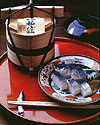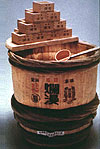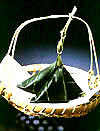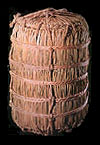Images



















|
II. Traditional innovation in Packaging
Traditional Japanese packaging embodies the spirit of the Japanese. Now let's see what kind of messages are contained.
1. Security
Behind the quest for preserving food is the desire to have a secure tomorrow. Why package the food? The reason is to ensure its purity and to protect it from the hands of evil spirits. The desire to preserve food led to innovative packaging that made rational use of nature's gift.
Rice balls.
This seemingly simple food contains many clever ideas. Rice ball comes in a convenient size and shape for eating. Salt sprinkled on the surface improve the taste and helps preserve the rice. Pickled plum on the inside prevents rotting, and its acidity blends well with the human body.
The seaweed on the outside is a convenient edible wrapping that prevents the rice from sticking to your fingers. It also adds a pleasant flavor.
The skin of the bamboo shoot has the right moisture for keeping a thin piece along the edge you instantly have a string to tie the package with.
Easy to carry, it returns to nature when thrown away.
If this were a recent innovation, it would certainly win the food package of the year prize.
As edible wrapping, seaweed takes on various forms. Sushi is the prototype of preserved food. The rice, seasoned with vinegar, blends well with the aroma of the cedar container.
 plants and trees abundant in nature were often used as natural packaging. Most commonly used were bamboo grass.
plants and trees abundant in nature were often used as natural packaging. Most commonly used were bamboo grass.
This is a sweet bean rice cake wrapped in bamboo grass, which incidentally has sterilizing property. The flavor of the bamboo grass enhances the taste.
Trout sushi.
Vinegared rice and trout are wrapped in bamboo grass and compressed in a thin wooden box. It's a long lasting, tasty dish.
 Sweet bean dessert called yokan.
Sweet bean dessert called yokan.
The dessert is placed in half a bamboo, which adds flavor and allows portability.
Mackerel sushi wrapped in dried bamboo shoot.
There are also a wide variety of packaging made of straw and rice plant.
Egg wrapped in straw.
Straw serves as a mild shock-absorber and makes the egg look fresh. The egg are boldly exposed, like swim suits in fashion. Too bad the egg don't look sexier.
When the straw is woven, tofu can be packaged.
Very simple, but effective.
This is baked fish wrapped in straw.
In this manner, the fruits of the sea can be carried up to a remote mountain village.

Here's something big ...a straw rice sack. The right size and weight for one man to carry, this sack contains enough rice to feed one person for a year.
Incidentally, sumo wrestling initially started out as a test of strength among laborers who carried rice sacks from dock to warehouse.
The height of the straw rice sacks corresponds to the degree of security.
Rice wine contained in a wooden keg is further wrapped with a rush-mat. This is usually used for festive occasions.

Sake was also packaged in gourds and ceramic bottles. Often in Kabuki play there appears an Edo traveler carrying a sake gourd, which is light and portable.
The largest sake package is the ceder barrel with stripes of bamboo. Some come with a spout. And on festive occasions, the lid is broken with a hammer and the sake passed around for all to enjoy.
 Also a square wooden cup is used for drinking.
Also a square wooden cup is used for drinking.
   
Think Visually, Act Graphically!
|